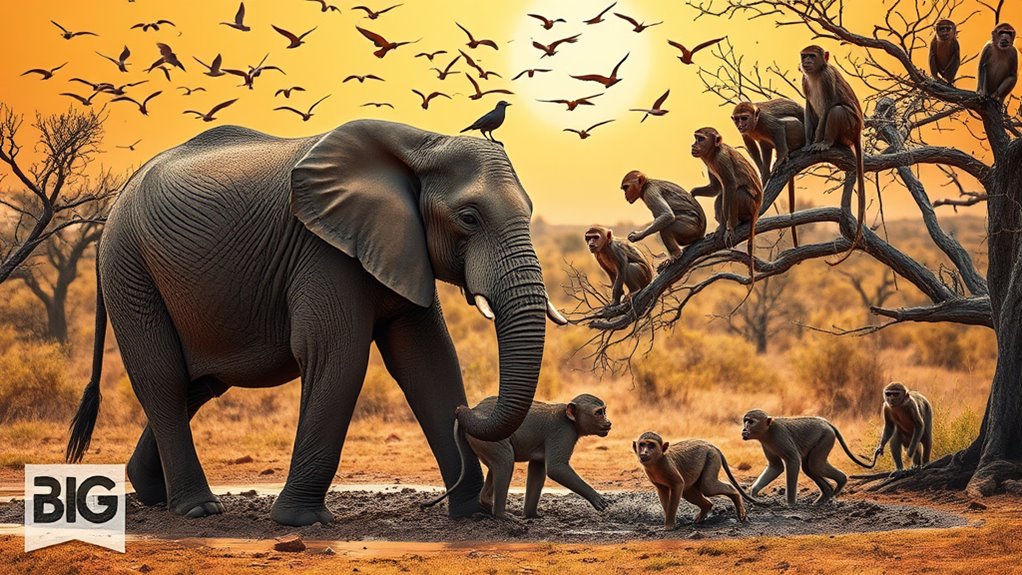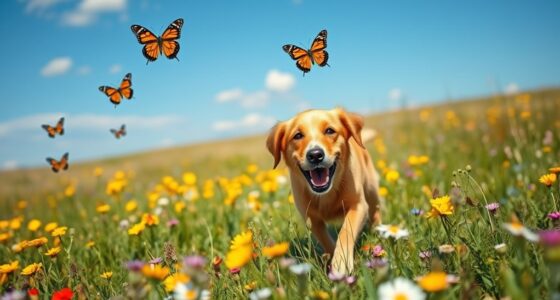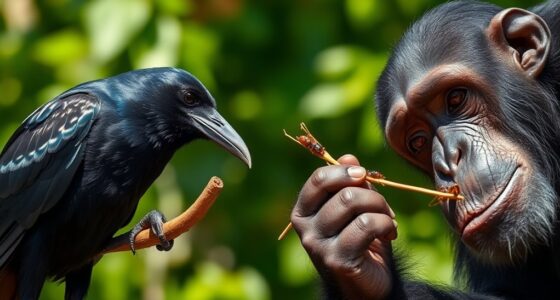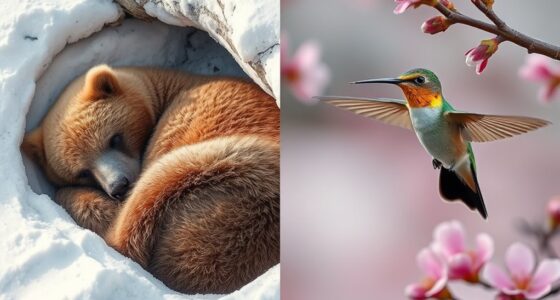Yes, animals do help each other, often at their own expense. This behavior, known as altruism, shows that cooperation is essential in the animal kingdom. From primates grooming each other to vampire bats sharing food, these acts enhance survival and strengthen social bonds. Such behaviors not only promote group safety but also improve individual chances of survival in harsh environments. If you’re curious about more examples and strategies animals use to cooperate, there’s much more to uncover.
Key Takeaways
- Altruism in animals involves behaviors where individuals help others at their own expense, promoting group well-being.
- Cooperation strategies, such as reciprocal altruism, enable animals to assist each other for mutual benefit.
- Examples include primates grooming to strengthen social bonds and improve overall health, enhancing survival chances.
- Vampire bats share food with less fortunate members, ensuring group longevity and reinforcing cooperative behavior.
- Altruism evolved as a survival tactic, leading to complex social structures essential for thriving in the wild.
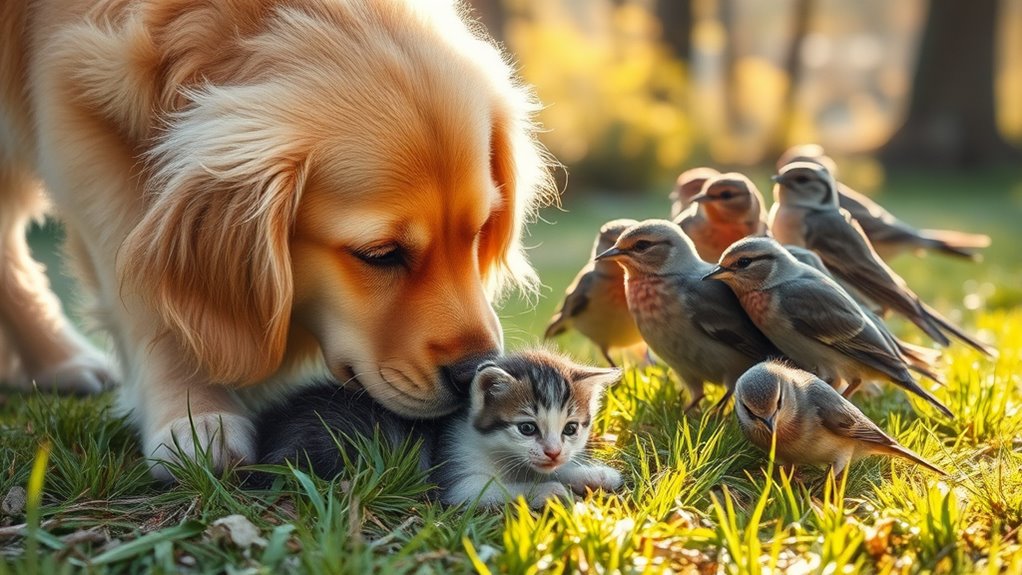
Have you ever wondered why some animals go out of their way to help others, even at their own expense? This intriguing behavior, known as altruism, has puzzled scientists and animal lovers alike. It’s fascinating to think that these creatures often prioritize the well-being of others, sometimes risking their own safety or resources. This phenomenon raises questions about the evolution of altruism and the various animal cooperation strategies that have developed over time.
The evolution of altruism in animals is a remarkable topic. While you might expect the survival of the fittest to dominate, altruistic behaviors can actually enhance the survival of a species. Animals often form close-knit groups, where cooperation becomes essential. By working together, they can achieve tasks that would be impossible alone, like hunting for food or protecting their young from predators. This cooperation leads to a mutual benefit, reinforcing the idea that helping others can ultimately benefit oneself.
Altruism can enhance species survival, showcasing how cooperation leads to mutual benefits in the animal kingdom.
Take, for example, certain species of primates. They’ve been observed grooming each other, which may seem trivial but serves essential purposes. Grooming not only strengthens social bonds, it also helps reduce stress and improves overall health. By taking the time to care for one another, these primates create a supportive environment that enhances their chances of survival. You might find it inspiring how these animals instinctively understand that cooperation can lead to better outcomes for everyone involved. Additionally, regular prenatal check-ups for pregnant animals can play a crucial role in their overall health and well-being, just as it does in humans.
Different animal cooperation strategies also contribute to the development of altruism. In some species, you’ll see reciprocal altruism, where individuals help each other with the expectation of receiving help in return. This creates a network of support that can be indispensable for survival in hostile environments. For instance, vampire bats share food with their less fortunate companions, ensuring that everyone has a chance to live another day. This behavior isn’t just about kindness; it’s a calculated strategy that guarantees the longevity of the group.
Ultimately, altruism in animals isn’t merely an act of kindness; it’s a survival tactic that has evolved over millions of years. As you observe these behaviors in nature, you can appreciate the complex social structures that animals create. Whether it’s through grooming, sharing food, or protecting one another, the evolution of altruism highlights the importance of cooperation in the animal kingdom. It reminds us that even in the wild, kindness and teamwork play indispensable roles in survival.
Frequently Asked Questions
What Species Exhibit the Most Notable Examples of Altruism?
You’ll find notable examples of altruism in species like elephants, meerkats, and certain primates. These animals engage in mutual aid, helping others in their group, often at a cost to themselves. Cooperative breeding is another fascinating aspect; species like the African wild dog and some birds rely on group members to raise offspring, sharing responsibilities and resources. This teamwork not only strengthens bonds but enhances survival for the entire group.
How Do Researchers Measure Altruistic Behavior in Animals?
To measure altruistic behavior in animals, researchers often use behavioral experiments and observational studies like a painter uses a canvas. They create scenarios where animals can choose to help others and observe their choices. Through careful analysis, they capture instances of cooperation or selflessness, revealing the intricate brushstrokes of social interactions. This combination of direct experimentation and watching natural behaviors helps uncover the deeper motivations behind altruism in various species.
Are There Evolutionary Advantages to Altruism in Animals?
Yes, there are evolutionary advantages to altruism in animals. You’ll find that through cost-benefit analysis, animals often weigh the risks of helping others against the potential benefits. Kin selection plays a key role, as helping relatives increases the chances of shared genes surviving. By assisting family members, you’re indirectly promoting your own genetic success, which strengthens the species over time. This cooperative behavior can enhance survival and reproductive success for both individuals and their kin.
Can Altruism in Animals Be Observed in the Wild?
Yes, you can observe altruism in animals in the wild. You’ll see behavioral reciprocity when animals help each other, sharing food or warning of predators. You’ll also notice kin selection, as animals often assist their relatives, increasing the survival of shared genes. Whether it’s a dolphin helping a stranded companion or birds feeding their siblings, these acts highlight the complex social dynamics at play in nature, showcasing the bonds that form within species.
How Does Altruism Differ Between Species?
Altruism differs between species mainly through the mechanisms of mutual support and kin selection. In some species, you’ll notice that animals provide help mainly to their relatives, enhancing their own genetic success. For example, you might see bees working tirelessly for the hive’s survival, demonstrating kin selection. In contrast, other species exhibit broader altruistic behaviors towards non-relatives, showcasing a more complex social structure and a different understanding of mutual support within their communities.
Conclusion
As you watch the animal kingdom unfold, you can almost feel the tension in the air. A wolf nudges its injured packmate, a dolphin circles protectively around a struggling companion. These moments challenge what you thought you knew about nature’s ruthless laws. Just when you think survival reigns supreme, the unexpected happens—acts of kindness bloom in the wild. Will you ever look at these creatures the same way again? The echoes of their altruism linger, beckoning you to ponder deeper.
